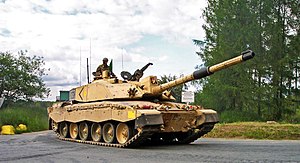Our website is made possible by displaying online advertisements to our visitors.
Please consider supporting us by disabling your ad blocker.
Tank classification
This article possibly contains original research. (September 2009) |

Tank classification is a taxonomy of identifying either the intended role or weight class of tanks. The classification by role was used primarily during the developmental stage of the national armoured forces, and referred to the doctrinal and force structure utility of the tanks based on design emphasis. The weight classification is used in the same way truck classification is used, and is intended to accommodate logistic requirements of the tanks.
Many classification systems have been used over a hundred years of tank history. An early division in the definition of roles was between infantry tanks intended to focus on supporting infantry in the assault, and cruiser tanks intended for classic cavalry missions of exploitation, screening and reconnaissance. As World War II progressed, the separation of "infantry" and "cruiser" roles generally disappeared and the "universal tank" started to take over.
Classification has always been determined by the prevailing theories of armoured warfare, which have been altered in turn by rapid advances in technology. No one classification system works across all periods or all nations; in particular, weight-based classification was inconsistent between countries and eras.
With the worldwide adoption of the modern main battle tank designs, which favour a modular universal design, these sorts of classifications are mostly eliminated from modern terminology. All main battle tanks are typically armed with weapons with similar characteristics but some may be armoured more than others. These are complemented with light tanks, typically in the role of (armed) reconnaissance.
Previous Page Next Page


